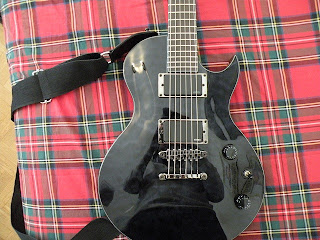Labels
BASS
(50)
COMPRESSION
(32)
DRUMS
(45)
EFFECTS
(49)
EQUALIZATION
(30)
GUITAR
(112)
HOME RECORDING
(95)
IMPULSES
(21)
INTERVIEWS
(19)
KARAOKE
(1)
LIVE
(10)
MASTERING
(61)
MIDI
(21)
MIXING
(179)
REVIEWS
(156)
SAMPLES
(69)
SONGWRITING
(19)
SYNTH
(3)
VOCALS
(31)
Sunday, April 29, 2012
HOW TO CHANGE GUITAR / BASS STRINGS (a guide for dummies)
Hello and welcome to this week's article!
Today we are going to talk about how to change your guitar / bass strings. Last week we have already seen how to remove the old strings, on our article about how to clean your guitar / bass, now we must take on to the next step: installing the new strings (Click Here for a dedicated article with Everything about Strings!)
The first thing to think about is the strings gauge: the thicker our strings are, the easier we can achieve lower tunings without having them too flabby and out of tune. For example if you are used to have the gauge of your thinnest string (usually the "high E") .009, with the guitar tuned in E, you might want to use a .010 to tune your guitar in D, a .011 to tune it in C and so on, to keep it in tune and with the right string tension.
There are many string producers around, the most famous of which are Ernie Ball, D'Addario and Elixir; these last ones features a specific coating to protect them against the hands sweat and dirt, therefore prolonging their life.
- To install the new strings on a Guitar, pass them through the tailpiece (according to the kind of bridge, wheter it's tune o matic, a floyd rose, a Gibraltar...) and then insert the string on the nut and the tuning post, but not at the full tension: place your hand between the string and the fretboard, perpendicular: the distance must be about 10cm, so that when you start winding, you can wrap the string a bit (at least three wraps) around the post before having it perfectly in tune.
Now, before starting winding, let's pass the part of the string that has passed through the tuning post under the string itself (the part before the tuning post, between the nut and the post), and then pass it again over it, in order to "lock" the string around the tuning post.
In order to wind the string faster, you can use your hand or a String Winder, anyway in in the "winding phase" just keep in mind that the string should wrap the tuning post from the bottom up, so direct the spire with your finger while winding.
- In order to change the strings on a Bass, instead, you can use the same method, but you can't lock the string on the tuning post, so just create an angle on the string and make it pass through the post, then wind it DOWNWARD (on the guitar we've seen it's better to do it upwards), until it reaches the right tuning.
After the new strings are mounted and tuned, we can remove the exceeding part of the string from the tuning post, using a sharp pair of cutters.
Become fan of this blog on Facebook! Share it and contact us to collaborate!!
Subscribe to:
Post Comments (Atom)


No comments:
Post a Comment